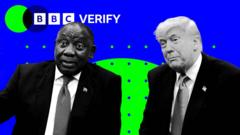Donald Trump confronted South African President Cyril Ramaphosa during a charged meeting at the White House, centered around contested claims regarding the violence faced by white farmers in South Africa. Initially cordial, the atmosphere shifted dramatically as Trump presented a video depicting opposition political figures advocating for violence against white farmers, along with images that he claimed highlighted a "burial site" for murdered farmers.
The video showcased rows of white crosses that Trump asserted marked the graves of over a thousand slain white farmers. However, this claim was quickly debunked. The crosses were actually part of a temporary memorial for a farming couple who were tragically murdered, not burial sites. Rob Hoatson, an organizer of the memorial event, clarified to the BBC that the crosses have since been removed and that the memorial was intended to honor the victims of violence rather than represent mass graves.
Furthermore, Trump made references to a purported "white genocide" in South Africa, echoing claims he has made in the past. While South Africa grapples with high murder rates, the statistics reveal that only a small fraction of murders involve white farmers. The South African Police Service reported 26,232 murders last year, of which only 44 were killings in the farming community, and only eight of those were farmers. The suggestion of a systemic genocide lacks substantial evidence and has been dismissed by legal authorities within South Africa.
The meeting escalated as Trump showcased footage from political rallies, including one where attendees sang “Kill the Boer,” a song characterized as hate speech by South African courts. Trump described the performers as public officials; however, many were not in official government positions. For instance, Julius Malema, who led the singing, was formerly part of the ANC's youth wing but has no current ties to government. In response to Trump, Ramaphosa stated that the political stance of the Economic Freedom Fighters, who performed the song, does not reflect the government's policies.
Trump also presented various articles as "evidence" supporting his claims, but at least one key image he used was mislocated—it depicted violence in the Democratic Republic of Congo, not South Africa. These inaccuracies raise critical questions about the narratives surrounding the safety and treatment of white farmers in South Africa, revealing a stark contrast between the claims made by Trump and the factual reality on the ground.


















